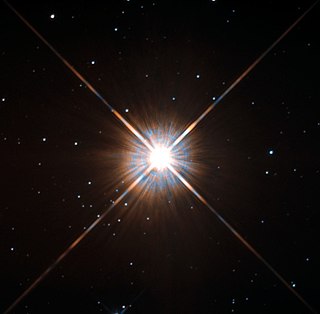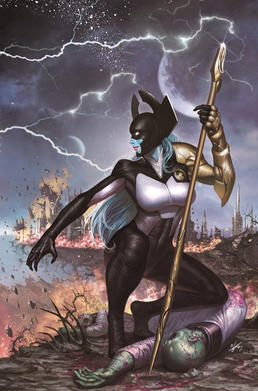
Alpha Centauri is a triple star system in the southern constellation of Centaurus. It consists of three stars: Rigil Kentaurus, Toliman, and Proxima Centauri. Proxima Centauri is the closest star to the Sun at 4.2465 light-years (1.3020 pc).

Proxima Centauri is the nearest star to Earth after the Sun, located 4.25 light-years away in the southern constellation of Centaurus. This object was discovered in 1915 by Robert Innes. It is a small, low-mass star, too faint to be seen with the naked eye, with an apparent magnitude of 11.13. Its Latin name means the 'nearest [star] of Centaurus'. Proxima Centauri is a member of the Alpha Centauri star system, being identified as component Alpha Centauri C, and is 2.18° to the southwest of the Alpha Centauri AB pair. It is currently 12,950 AU (0.2 ly) from AB, which it orbits with a period of about 550,000 years.

Pangaea Proxima is a possible future supercontinent configuration. Consistent with the supercontinent cycle, Pangaea Proxima could form within the next 250 million years. This potential configuration, hypothesized by Christopher Scotese in November 1982, earned its name from its similarity to the previous Pangaea supercontinent. Scotese later changed Pangaea Ultima to Pangaea Proxima to alleviate confusion about the name Pangaea Ultima which could imply that it would be the last supercontinent. The concept was suggested by extrapolating past cycles of formation and breakup of supercontinents, not on theoretical understanding of the mechanisms of tectonic change, which are too imprecise to project that far into the future. "It's all pretty much fantasy to start with," Scotese has said. "But it's a fun exercise to think about what might happen. And you can only do it if you have a really clear idea of why things happen in the first place."

Próxima Estación: Esperanza is the second solo album by Manu Chao. The album was released in Europe in 2001. It was released in the United States on 5 June 2001 on Virgin Records.
A Próxima Vítima is a Brazilian telenovela that was produced and aired by TV Globo from March 13, 1995, to November 3, 1995, totaling 203 chapters.

Proxima Midnight is a supervillain appearing in American comic books published by Marvel Comics. Created by writer Jonathan Hickman, she first appeared in New Avengers #8. She is a prominent member of the Black Order working for Thanos.
Serixia is a genus of longhorn beetles of the subfamily Lamiinae, containing the following species:

The Black Order is a supervillain team appearing in American comic books published by Marvel Comics. Created by writer Jonathan Hickman, they are a group of alien warriors with various supernatural abilities who serve Thanos. The original iteration, introduced in the 2013 Infinity storyline following a cameo appearance in The New Avengers #8, consists of Ebony Maw, Corvus Glaive, Proxima Midnight, Black Dwarf, and Supergiant, with Black Swan later joining the group as well.
A Próxima Atração is a Brazilian telenovela produced and broadcast by TV Globo. It premiered on 26 October 1970 and ended on 17 April 1971, with a total of 150 episodes. It's the seventh "novela das sete" to be aired at the timeslot. It is created by Vicente Sesso and directed by Régis Cardoso.

Proxima Centauri b, also referred to as Alpha Centauri Cb, is an exoplanet orbiting within the habitable zone of the red dwarf star Proxima Centauri, which is the closest star to the Sun and part of the larger triple star system Alpha Centauri. It is about 4.2 light-years from Earth in the constellation Centaurus, making it and Proxima d, along with the currently disputed Proxima c, the closest known exoplanets to the Solar System.

Amanita proxima is a species of Amanita from France, Italy, and Spain. It is poisonous.
Serixia buruensis is a species of beetle in the family Cerambycidae. It was described by Stephan von Breuning in 1958.
Serixia cinereotomentosa is a species of beetle in the family Cerambycidae. It was described by Stephan von Breuning in 1958.
Serixia novaebritanniae is a species of beetle in the family Cerambycidae. It was described by Stephan von Breuning in 1958.
Serixia longicornis is a species of beetle in the family Cerambycidae. It was described by Francis Polkinghorne Pascoe in 1858.
Serixia prolata is a species of beetle in the family Cerambycidae. It was described by Francis Polkinghorne Pascoe in 1858.
Serixia sedata is a species of beetle in the family Cerambycidae. It was described by Francis Polkinghorne Pascoe in 1862.

Proxima Centauri c is a controversial exoplanet candidate claimed to be orbiting the red dwarf star Proxima Centauri, which is the closest star to the Sun and part of a triple star system. It is located approximately 4.2 light-years from Earth in the constellation of Centaurus, making it, Proxima b, and Proxima d the closest known exoplanets to the Solar System.

BLC1 was a candidate SETI radio signal detected and observed during April and May 2019, and first reported on 18 December 2020, spatially coincident with the direction of the Solar System's closest star, Proxima Centauri.

Proxima Centauri d is a candidate exoplanet orbiting the red dwarf star Proxima Centauri, the closest star to the Sun and part of the Alpha Centauri triple star system. Together with two other planets in the Proxima Centauri system, it is the closest known exoplanet to the Solar System, located approximately 4.2 light-years away in the constellation of Centaurus. The first signs of the exoplanet emerged as a weak 5.15-day signal in radial velocity data taken from the Very Large Telescope during a 2020 study on Proxima b's mass. This signal was formally proposed to be a candidate exoplanet by Faria et al. in a follow-up paper published in February 2022.










